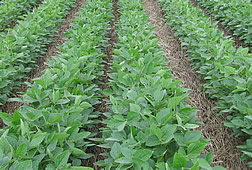This page has been archived and is being provided for reference purposes only. The page is no longer being updated, and therefore, links on the page may be invalid.
|
|
Researchers Roll Out the Rye to Rein In Weeds
By Jan SuszkiwJuly 27, 2007
Rather than till crop fields to disrupt weeds—and risk losing soil to erosion—organic soybean growers should take note of Agricultural Research Service (ARS) studies in Urbana, Illinois.
There, ARS ecologist Adam Davis is experimenting with a no-till system that calls for flattening seven-foot-tall stands of cereal rye into dense vegetative mats that secure the soil and curtail weeds like giant foxtail so that soybean plants can grow uncontested. Davis envisions soy growers using the rolled-rye cover in an integrated approach to weed control.
In two years of field studies conducted by Davis near the ARS Invasive Weeds Management Research Unit in Urbana, soybeans grown in rolled-rye fields averaged 40 bushels (2005) and 33 bushels (2006) of seed per acre. No-till soybean controls treated with glyphosate at half or full strength produced nearly 50 bushels per acre.
Organic soybean growers forgo herbicide use and instead rely on tillage and other cultivation measures to control weeds. But such measures can necessitate making up to 10 trips into the crop field, which increases fuel and labor costs. By establishing a stand of rye in the fall and rolling it flat in late May, growers need only make one trip. That's because weeds are suppressed both before and after the stand is rolled.
The key to the approach is a specialized, multi-bladed roller that attaches to a tractor's front or back end. As the tractor moves through a field, the roller crimps the rye plants' stems and flattens them into a two-inch-thick matted mulch. A planter accompanying the roller then deposits soybean seeds into the soil beneath, eliminating the need for tillage.
Davis learned of the rollers, designed by scientists at The Rodale Institute in Kutztown, Pa., while doing postdoctoral research with Dale Mutch in 2004 at Michigan State University's Kellogg Biological Station in Hickory Corners. There, organic soybeans grown in rolled-rye or hairy vetch mulches yielded 58 to 62 bushels per acre on sandy loam soils.
Davis joined the ARS Urbana unit in 2005 and expanded on the Michigan work to include conventionally grown soybeans.
ARS is the U.S. Department of Agriculture's chief scientific research agency.

